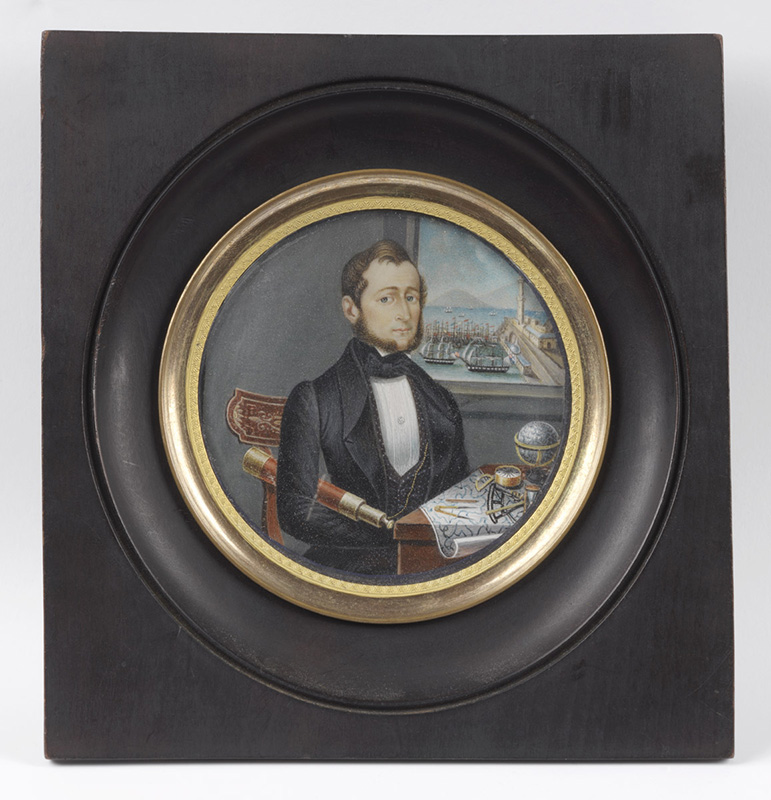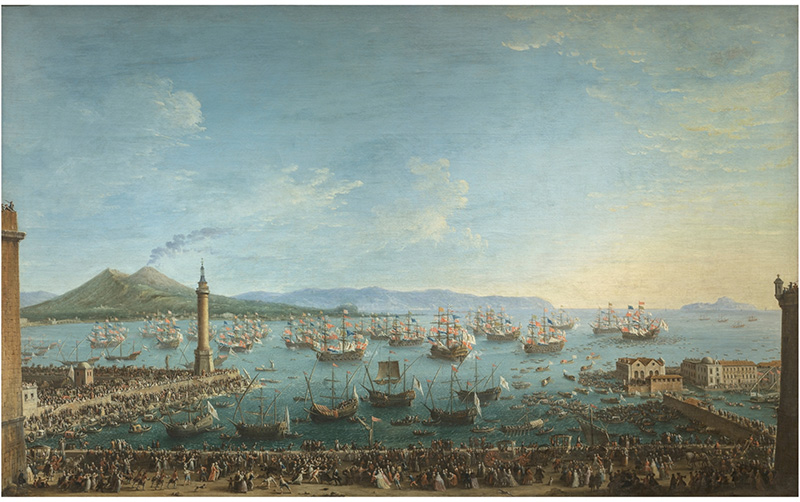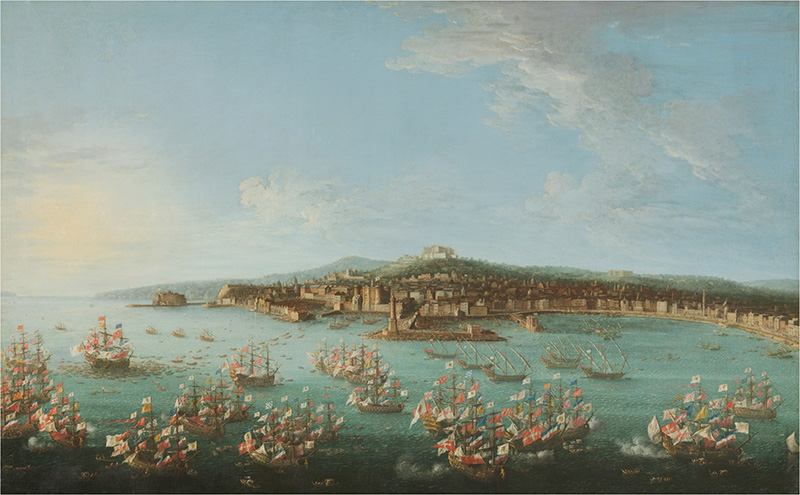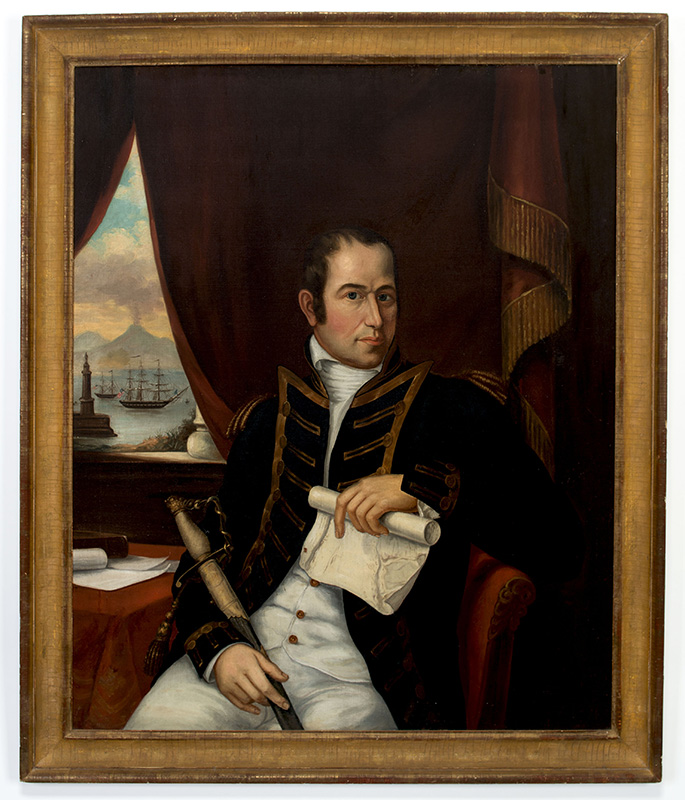A Room with a View: Researching a Miniature Portrait at Winterthur
by Ann Hewitt
In the Winterthur Museum collection, there is an intriguing miniature watercolor portrait painted on ivory that was acquired by Henry Francis du Pont in 1957 from an art dealer in New York.1 Although of unknown provenance, the portrait is thought to portray an early-19th-century merchant marine captain. It depicts a gentleman with a telescope tucked under his right arm, seated at a desk laid out with a nautical chart and navigational instruments to plot coordinates (figure 1). A large window’s view reveals a maritime world; with an enclosed harbor composed of wharves and a jetty supporting a lighthouse and perhaps chandlers. Two large ships are seen departing from this port, and a row of vessels are moored on the far side dock. In the distance, several ships are sailing in front of mountainous terrain. A generous Decorative Arts Trust Research Grant allowed me to visit museum collections and libraries in the United Kingdom and in the United States to study maritime painting and material culture.
Portraits of ship captains holding a telescope are not uncommon in early-19th-century iconography, nor are rooms with a view. Although these outside views are less common on miniatures due to their diminutive size, they do exist.2 The captain portrayed in the Winterthur Museum miniature is dressed in the aristocratic fashion of the early 19th century, typified by the puffed sleeve black waist coat and white pleated linen or cotton shirt, with his cravat wrapped twice around his neck and tied. His velvet pin-dotted waistcoat holds a gold beaded watch chain, and an ornament, perhaps a masonic emblem, is attached to a button. He is dressed in a manner that reflects his wealth, as well as surrounded by items that explain his interest or occupation. We are meant to see this picture and immediately know who and what he is.
Considering the focus of the Winterthur collection on American art, the background of the painting stood out, and I wondered if it was an imaginary scene or an actual place. Traditionally ports on the East Coast of the United States were built on wood pilings, whereas on this miniature the pier is constructed of masonry, characteristic of Mediterranean harbors.3 A similar scene with a lighthouse, an enclosed harbor, and mountains in the distance, is depicted in Antonio Joli’s 1759 pair of paintings (figures 2 and 3) of Charles of Bourbon leaving Naples to become King of Spain.4 Joli was a vedutisti who painted iconic cityscapes of Naples that were sought after by travelers on their Grand Tour of Italy. Gabriele Ricciardelli and Carlo Bonavia also painted this image of the Lanterna del Molo, the lighthouse at the end of the San Vincenzo pier with the gulf of Naples and the Mount Vesuvius complex in the background.5
The port of Naples, distinguished by the lighthouses and the view, would have been easily recognizable to Americans during the early-19th-century Barbary Wars. American merchants and navy sailing into the Mediterranean entered through the Strait of Gibraltar reprovisioned in Naples. Commodore Edward Preble took this course on his way to Tripoli, and the same Neapolitan-style lighthouse and seascape is visible in two large oil portraits of Preble, after Rembrandt Peale, in the United States Naval Academy Collection, as well as in an oil portrait of Edward Preble, painted by an unknown artist, is in the USS Constitution Museum (figure 4).6
Although we cannot identify with certainty the artist nor sitter of the Winterthur miniature portrait, we can at the very least place him in the Mediterranean port of Naples and imagine that he was one of the American captains of merchant ships that President Thomas Jefferson was intent on protecting from piracy during the Barbary Wars.
Ann Hewitt graduated from the Winterthur Museum Program in American Material Culture at the University of Delaware. She is currently a collections information specialist at the Detroit Institute of Arts.
1. This miniature was part of an exhibition organized by Martin Bruckner. Winterthur Museum, Garden & Library, 1957.0589A. 3.2 inches square. It is framed and covered with a convex piece of glass, protecting the image but preventing the study of brush strokes.
Portrait of Captain Robert Smith. Oil on wood. Mystic Seaport.
Isaac Sheffield, Portrait of Captain Lorenzo Dow Baker. Oil on canvas, 1836, http://mobius.mysticseaport.org/detail.php?kv=110952&module=objects. Mystic Seaport.
James Frothingham, Portrait of Elias Hasket Derby. Oil on panel, 1784. Peabody Essex Museum.
Portrait miniature of a sea captain. Watercolor on paper. The Huntington Library, Museum and Botanical Garden, Jonathan and Karin Fielding Collection.
2. Charles Wilson Peale painted a round and oval miniature while in London in 1767 of his good friend and benefactor John Beale Bordley sons who were studying abroad at Eton. In each, he portrayed the boys Matthias (1757–1818) and Thomas Bordley (1755–71) reading a book next to a marble bust of Minerva, the Roman god of Wisdom. On the Yale University Art Gallery miniature (accession number 1998.40.1), the view is of a hilly landscape with a large home, perhaps the Bordley home in Maryland. The miniature in the Smithsonian American Art Museum (accession number 1974.113) has a view of St Paul’s Cathedral in London. Charles Wilson Peale, Matthias (1757–1818) and Thomas Bordley (1755–1771). Watercolor over graphite pencil on ivory, 69 1767, https://artgallery.yale.edu/collections/objects/76826. Yale University Art Gallery.
3. Taylor, James, From James Taylor, January 19th, 2023.
4. Joli, A. (1759). Partida de Carlos de Borbón a España, vista desde la dársena, Museo Del Prado, Madrid, Spain. Museo Del Prado. Retrieved from https://www.museodelprado.es/en/the-collection/art-work/departure-of-charles-of-bourbon-for-spain-seen/ed767fad-3be6-4f3c-aa44-c9c31c20fec1.
Joli, A. (1759). Departure of Charles of Bourbon for Spain, seen from the Sea, Museo Del Prado, Madrid, Spain. Museo Del Prado. Retrieved from https://www.museodelprado.es/en/the-collection/art-work/departure-of-charles-of-bourbon-for-spain-seen/ed767fad-3be6-4f3c-aa44-c9c31c20fec1.
5. Ricciardelli, Gabriele. “The Lanterna Del Molo, Naples.” Compton Verney, 1740. Compton Verney. Warwickshire, England. https://www.comptonverney.org.uk/cv_collections/the-lanterna-del-molo-naples/.
Carlo, Bonavia. The Lanterna Del Molo, Naples with Vesuvius beyond; and Naples, with the Castel Dell’Ovo, oil on canvas, https://onlineonly.christies.com/s/old-master-paintings-sculpture/carlo-bonavia-active-naples-1751-1788-206/171201.
6. The background of the painting is likely Naples, Italy. The lighthouse is in the Neapolitan style and the mountains match the mountains in Naples. Logan, Tracy. Attention: Tracy Logan, Senior Curator. Mar. 2024.
Portrait of Commodore Edward Preble. Oil on canvas. USS Constitution Museum. The first painting, 1869.001.009 was transferred from the Navy department to the museum in 1869 and the other, 1970.035.006, was bequeathed to in them from RADM Dundas Preble Tucker, the last direct descendent of Commodore Edward Preble in 1978, though it was on loan to them before that.
About The Decorative Arts Trust Bulletin
Formerly known as the "blog,” the Bulletin features new research and scholarship, travelogues, book reviews, and museum and gallery exhibitions. The Bulletin complements The Magazine of the Decorative Arts Trust, our biannual members publication.
Click Images to Enlarge
Did you know that clicking on the images in Bulletin posts will allow you to get a closer look? Simply click on an image, and a larger version will open in a pop-up window.











